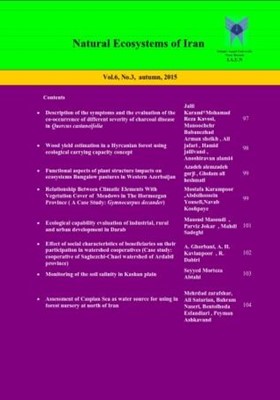ارزیابی توان اکولوژیک توسعه شهری، روستایی و صنعتی شهرستان داراب
الموضوعات :مسعود مسعودی 1 , پرویز جوکار 2 , مهدی صادقی 3
1 - دانشیار دانشگاه شیراز، دانشکده کشاورزی، بخش مهندسی منابع طبیعی و محیط زیست
2 - دانشگاه شیراز، دانشکده کشاورزی، بخش مهندسی منابع طبیعی و محیط زیست
3 - دانشگاه شیراز، دانشکده کشاورزی، بخش مهندسی منابع طبیعی و محیط زیست
الکلمات المفتاحية: توسعه, کاربری اراضی, ارزیابی توان اکولوژیک, شهرستان داراب,
ملخص المقالة :
استفاده از روش هایی عقلانی و نظام مند در مدیریت منابع و استفاده بهینه از آنها بسیار مهم است. این روش ها باید به نحوی باشد که توان و پتانسیل سرزمین را در نظر بگیرد در غیر این صورت خسارات جبران ناپذیری به منابع و سرزمین وارد می شود. ضرورت ارزیابی توان اکولوژیک کاربری توسعة شهری، روستایی و صنعتی به این معنی است که توان سرزمین مورد نظر چقدر است. با توجه به بحران های زیست محیطی حاصله در شهرستان داراب، هدف این تحقیق بر ارزیابی توان اکولوژیک شهرستان داراب برای توسعه شهری، روستایی و صنعتی و ارائه راهکارهایی است که در این زمینه جهت نیل به اهداف توسعه پایدار قرار خواهد گرفت. در همین رابطه توان اکولوژیک توسعه شهرستان داراب با استفاده از رویهم گذاری لایه های اطلاعاتی و جمع بندی آنها با بهره گیری از فن آوری GIS ارزیابی گردید. نتایج ارزیابی در دو کلاس نسبتا مناسب (2) و نامناسب (3) ارائه شد. در ضمن در این پژوهش درصد طبقات توان در برآورد استقرار فعلی کاربری های شهری، روستایی و صنعتی با رویهم گذاری لایه های پلی گونی شهری، نقطه ای روستاها و مناطق صنعتی شهرستان بر روی نقشه توان اکولوژیک انجام و وضعیت این مناطق مشخص گردید. با توجه به نتایج بدست آمده اکثر مناطق شهری، روستایی و صنعتی در طبقه سه یا نامناسب قرار دارند.
References
1- Adhami Mojarad, M. H., 1989. Comparison of three evaluation methods of natural resources, Msc. Thesis, Tehran University, 120 pp. (In Persain)
2- Chen, Sh., Sh. Zeng, and Ch. Xle, 2000.Remote Sensing and GIS for Urban Growth Analysis in China. Photogrammetric Engineering & Remote Sensing, 66 (5): 593-598.
3- Ferdowsi, B., 2005. Feasibility and application of decision support systems in the physical development of the city (Case Study: Sanandaj city). MSc thesis, Faculty of Humanities, Tarbiat Modares University. (In Persain)
4- Gharakhlou, M., H.R. Pourkhabbaz, M.J. Amiri, H. Faraji Sabokbar, 2009. Ecological Capability Evaluation of Qazvin Region for Determining Urban Development Potential Points Using Geographic Information System. Journal of Urban - Regional Studies and Research. Issue2. 51-68. (In Persain)
5- Karam, A., 2005. Land Suitability Analysis for Physical Development in North-West axis of Tabriz using multi-criteria approach (MCE) in GIS environment. Geographical Studies, 54: 93-106. (In Persain)
6- Kashisaz, M., M. Monavari, M. Afkhami, and A. Karbasi, 2010. Application of Analytic Hierarchy Process (AHP) in the evaluation of ecological capability for urban rural development (Case Study: Sidon region of Khuzestan). Environment and Development. 1 (1): 43-50. (In Persain)
7- Makhdoum, M., 1991. The evaluation of ecological land capability of Gilan and Mazandaran region for urban industrial development, and tourism. Journal of environmental studies, 16 (16): 81-100. (In Persain)
8- Makhdoum, M., 2006. Principles of Land use planning. 7th edn University of Tehran, 289 pp. (In Persain)
9- Makhduom, M., A. Darvishsefat, H. Jafarzadeh, and A. Makhdom, 2009. Environmental Evaluation and Planning by Geographic Information System. University of Tehran, 304 pp. (In Persian)
10- Monavari, S.M., S.M. Shariat, S. Dashti, and GH. Sabzghabaie, 2009. Evaluation of Environmental Capability of Zakherd watershed for urban development using GIS. Environmental Science and Technology, Issue1, 199-208. (In Persain)
11- Mozafari, GH., and A. Owlazadeh, 2008. A Study and Analysis of Physical Development of Saghez and its Future Optimization Development with the Use of GIS. Journal of environmental studies, 34 (47): 11-20. (In Persain)
12- Pauleit, S., and F. Duhme, 2000. GIS assessment of munich’s urban forest structure for urban planning. Journal of Arboriculture 26 (3), 133-141.
13- Pourahmad, A., H. Hataminejad, and S.H. Hosseini, 2006. Pathology the urban development plans in the country. Geographical Research, Issue 58. 167-180. (In Persain)
14- Pourahmad, A., K. Habibi, S.M. Zahraie, and S. Nazariadli, 2007. Using the fuzzy algorithms and GIS for mapping urban equipment (Case Study: Landfill Babolsar), Journal of environmental studies, 33 (42): 31-42. (In Persain)
15- Pourebrahim, SH., 2001. Planning for the future development of Qeshm in Planning Platform. MSc thesis, Faculty of Environment, Tehran University. (In Persain)
16- Pourjafar, M.R., M.R. Montazeralhojat, A. Ranjbar, and R. Kabiri, 2012. Appraising Ecological Power for Identifying Appropriate Districts for Development Around Sahand New Town. Geography and development Iranian journal. 10 (28): 11-22. (In Persain)
17- Rezaie, M., 2005. Physical Development of City and its environmental role (Case Study: Shiraz). MSc thesis, Faculty of Humanities, Tarbiat Modares University.
18- Sante-Riveira, I., R. Crecente-Maseda, and D. Miranda-Barros, 2008. GIS-based planning support system for rural land-use allocation. Computers and Electronics in Agriculture, 63, 257-273. (In Persain)
19- Sudhira, H.S., T.V. Ramachandra, and K.S. Jagadish, 2004. Urban sprawl: metrics, dynamics and modeling using GIS. International Journal of Applied Earth Observation and Geo information, 5: 29-39.
20- Zareie, R., and A. Alshekh, 2012. Modeling of Urban development using cellular automation model and Genetic Algorithm (Case Study: Shiraz city). Research and Urban Planning, 3 (11): 1-16. (In Persian.).


